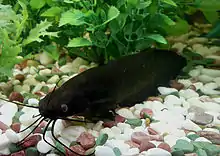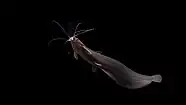| Heteropneustes fossilis | |
|---|---|
 | |
 | |
| Scientific classification | |
| Domain: | Eukaryota |
| Kingdom: | Animalia |
| Phylum: | Chordata |
| Class: | Actinopterygii |
| Order: | Siluriformes |
| Family: | Heteropneustidae |
| Genus: | Heteropneustes |
| Species: | H. fossilis |
| Binomial name | |
| Heteropneustes fossilis (Bloch, 1794) | |
| Synonyms | |
8Saccobranchus fossilis (Bloch, 1794) | |

The Asian stinging catfish or fossil cat (Heteropneustes fossilis) is a species of airsac catfish found in India, Bangladesh, Pakistan, Nepal, Sri Lanka, Thailand, Myanmar, and Bhutan. It has also been introduced to the Tigris River Basin in Iran.[1]
Description
.jpg.webp)
H. fossilis is found mainly in ponds, ditches, swamps, and marshes, but sometimes occurs in muddy rivers. It can tolerate slightly brackish water. It is omnivorous. This species breeds in confined waters during the monsoon, but can breed in ponds, derelict ponds, and ditches when sufficient rainwater accumulates. It is in great demand due to its alleged medicinal value.[2]
The stinging catfish is able to deliver a painful sting to humans. Poison from a gland on its pectoral fin spine has been known to be extremely painful.
This species grows to a total length of 30 cm (12 in), and is an important component of local commercial fisheries. It is also farmed and found in the aquarium trade.[2]
Name
In India, in Kerala, it is locally called kadu (Malayalam:കടു) or karri (Malayalam:കാരി). In Myanmar it is called Nga Kyee (Burmese: ငါးကျည်း). It is highly preferred in Assam and locally known as xingi maas (Assamese: শিঙি মাছ) or "na singgi" (Bodo). In Bangladesh, this fish is called singi mach (Bengali: শিং মাছ), In Sri Lanka, this fish is called hunga (හුංඟා) [3] by the Sinhala-speaking community.
References
- ↑ COAD, Brian W (2015). "Review of the Freshwater Catfishes of Iran (Order Siluriformes)". Iranian Journal of Ichthyology. 1 (4): 218–257.
- 1 2 Froese, Rainer; Pauly, Daniel (eds.) (2011). "Heteropneustes fossilis" in FishBase. December 2011 version.
- ↑ "Freshwater fish of Sri Lanka". TropicalFreshwaterFish.com. Retrieved 2023-06-14.
